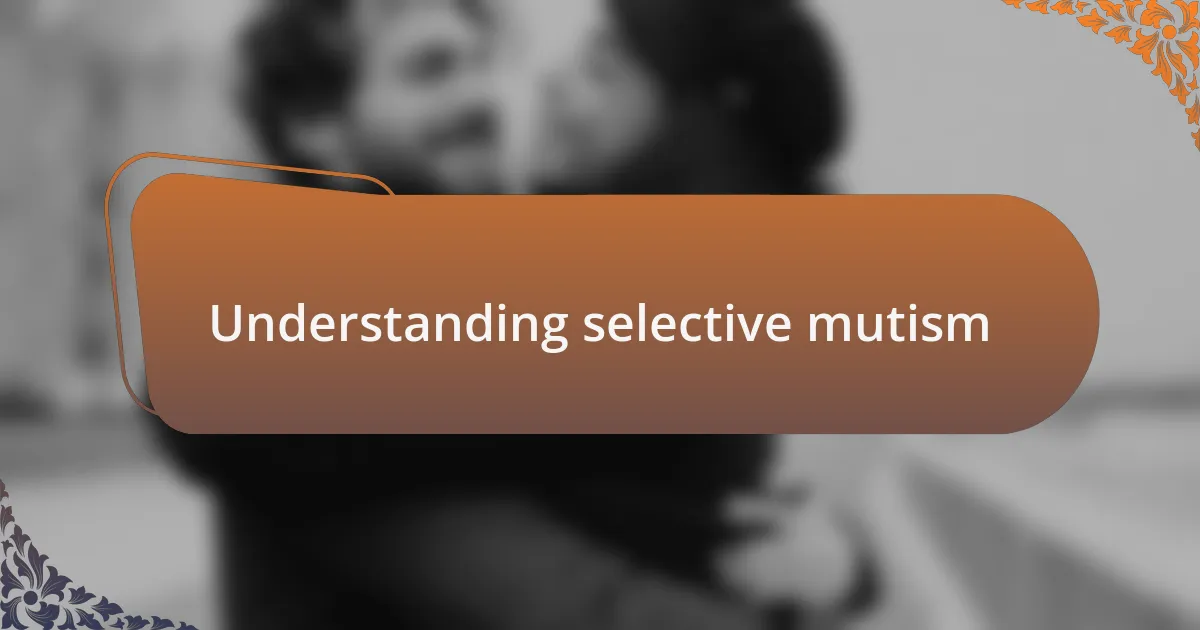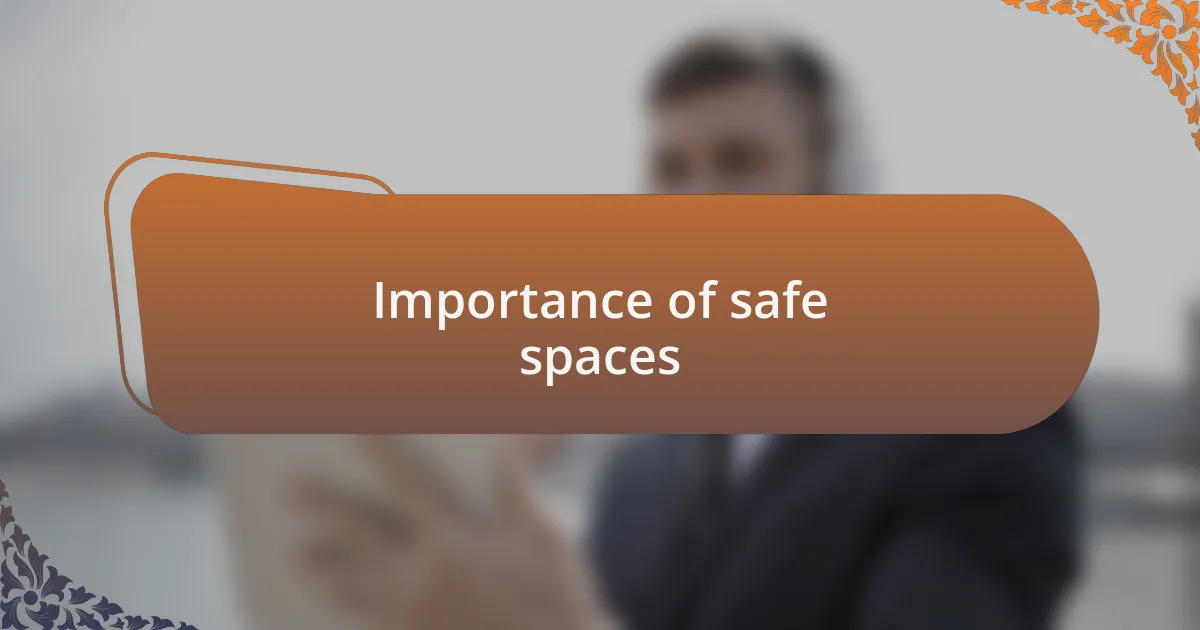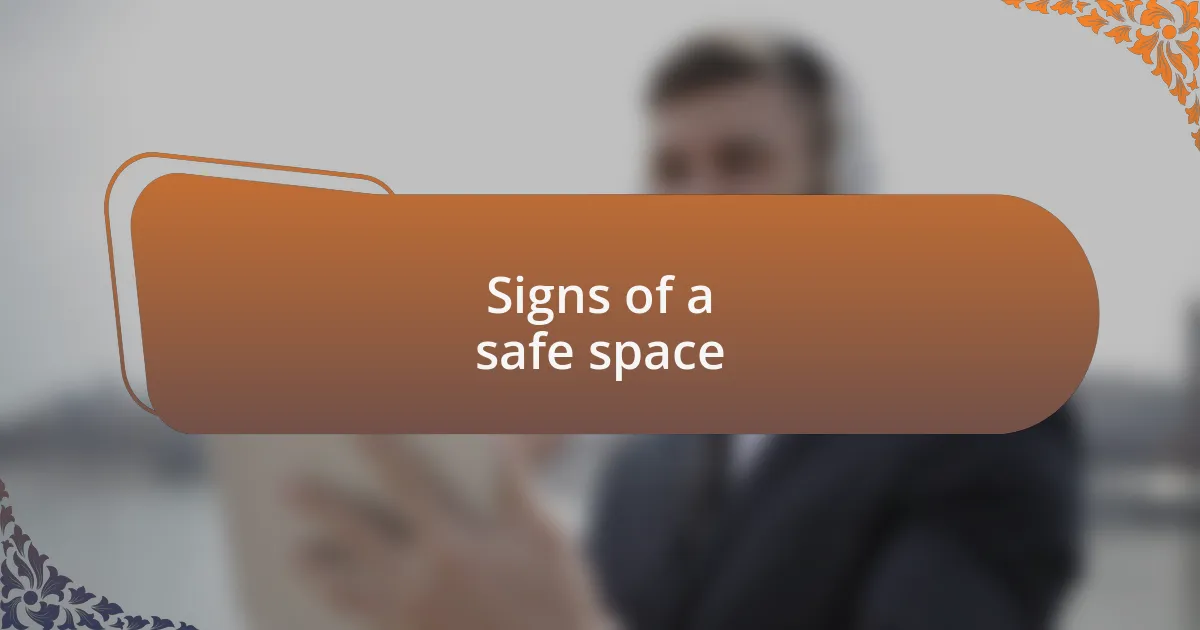Key takeaways:
- Selective mutism is a serious condition often mistaken for shyness, primarily linked to anxiety in childhood.
- Safe spaces are essential for individuals with selective mutism, providing comfort, understanding, and opportunities for self-expression.
- Signs of a safe space include a calm atmosphere, understanding individuals, and an inclusive environment that fosters connection.
- Sharing personal stories in supportive settings can empower individuals and create bonds through shared experiences and empathy.

Understanding selective mutism
Selective mutism is often misconceived as mere shyness, but it’s much more profound. I remember the first time I realized I was paralyzed by the overwhelming urge to speak yet unable to form the words—a feeling that isolated me in social settings. How frustrating it was to see others communicate effortlessly while I felt like a silent observer in my own life.
This condition typically manifests in childhood, often alongside anxiety. I recall my own experiences in school where the pressure to speak in class felt like an insurmountable challenge. Have you ever felt the weight of everyone’s expectations? It’s a heavy load to bear when your voice feels trapped inside.
Understanding selective mutism requires empathy and patience, as it is not a choice but a response to intense feelings of anxiety. I often found solace when I was surrounded by trusted friends who created a judgement-free zone. Doesn’t it make sense that having a safe space can make all the difference for those of us grappling with this silent struggle?

Importance of safe spaces
When it comes to selective mutism, safe spaces play a crucial role in providing comfort and understanding. I vividly remember sitting in a cozy corner of a friend’s home, filled with familiar scents and laughter, where I felt free to express myself without fear. This comforting environment allowed me to slowly shed my anxieties and find my voice.
Moreover, safe spaces act as nurturing environments where individuals struggling with selective mutism can gradually build confidence. In one setting, I experienced how the absence of judgment created opportunities for me to whisper my thoughts freely. Have you ever found that one spot where your worries seem to fade away? That’s the magic of a supportive space—it feels like a protective bubble amid a world that can be overwhelming.
The importance of these safe havens cannot be overstated; they serve as vital foundations for emotional growth. For instance, I recall participating in small group discussions about our feelings, which felt manageable when I was among understanding peers. It’s incredible how a simple shift in atmosphere can encourage someone to take that brave step toward self-expression.

Signs of a safe space
When I think of the signs of a safe space, one standout characteristic is the palpable sense of calm it brings. I remember stepping into a friend’s backyard on a sunny day, the sound of birds chirping in the background. That serenity reassured me, making it easy to let my guard down and share my thoughts without worrying about being judged. Can you recall a moment where the atmosphere just felt right, like a gentle hug?
Another strong indicator is the presence of understanding individuals. I once joined a discussion group where everyone shared their experiences with selective mutism. The moment someone spoke about their own struggles, I felt an instant connection. It reminded me that I wasn’t alone, and that shared vulnerability created an atmosphere where speaking up felt less daunting. Don’t you find strength in knowing others relate to your journey?
Additionally, a safe space often feels inclusive and inviting. I vividly recall sitting in a small café with supportive friends where laughter and acceptance filled the air. Just being surrounded by people who were genuinely interested in listening made all the difference. Have you ever felt that sense of belonging simply because of the warmth radiating from those around you? That’s the essence of a real sanctuary.

Sharing my story with others
Sharing my story with others has always been an empowering experience for me. I remember the first time I opened up to a group about my selective mutism; it felt like shedding a heavy coat I had worn for years. Did you ever feel that relief when someone finally understands you? It’s liberating to communicate my feelings, knowing that each word shared chips away at the isolation I often felt.
I often find that vulnerability invites connection. When I revealed my struggles in a safe space, I could see the expressions of empathy mirrored in the faces around me. It was astonishing to realize how many shared my fears, and at that moment, it felt as if we were weaving together our collective stories to create a tapestry of support. Have you experienced the power of storytelling in building bridges with others?
The aftermath of sharing my experiences often leaves me feeling lighter, as though a burden has been lifted. I once crafted a post on a community forum, detailing my encounters with public speaking anxiety. The responses were overwhelming; people reached out to express their own situations, and I felt an unmistakable bond forming. Isn’t it incredible how our stories can resonate with others and foster a sense of unity?